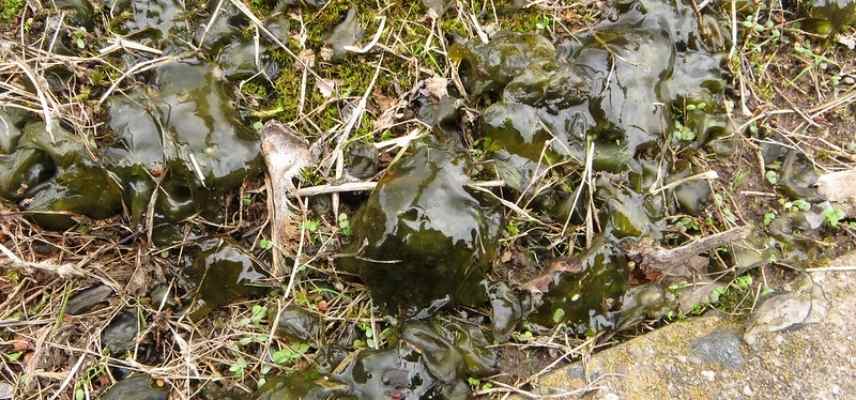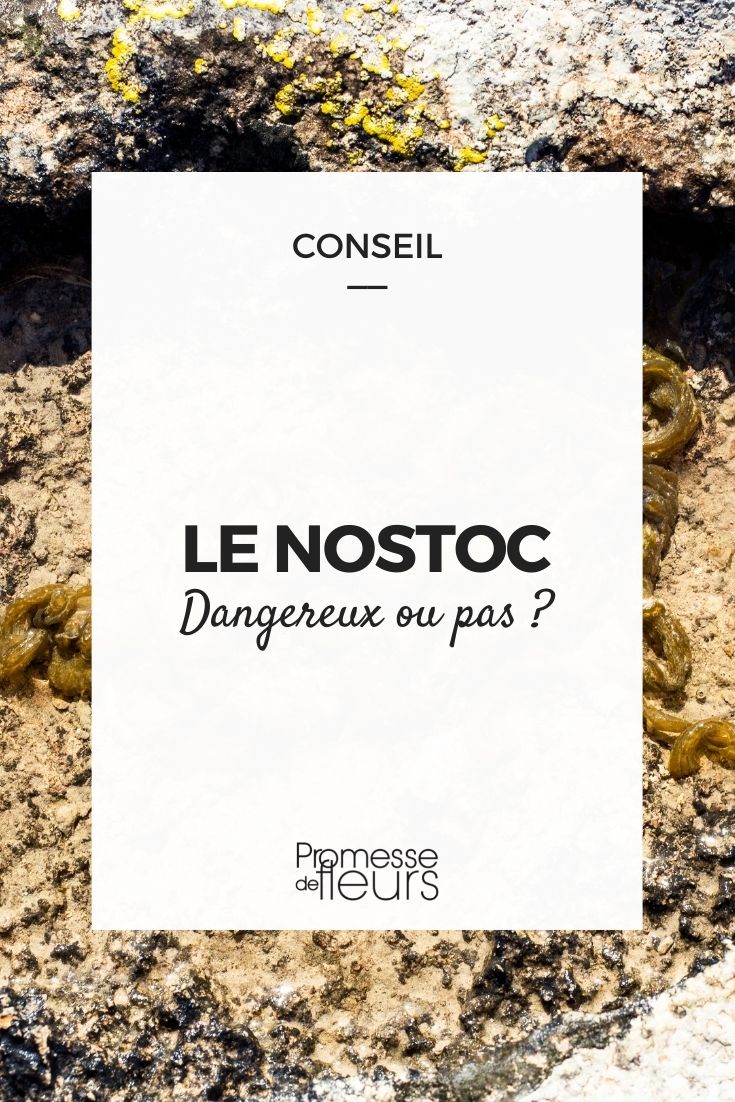
Nostoc commune or Moon's Spittle: what is it?
In any case, it's neither an alga nor a fungus!
Contents
But, what on earth is this blackish gelatinous substance, this strange dark green goo that seems to have fallen from the sky? Is it a weird fungus? An alga dropped by a seabird? No, no, none of that! You are currently discovering a colony of nostoc, a bacterium capable of performing photosynthesis. Is the “moon spit” dangerous? Why has it suddenly appeared? What can be done to remedy this “invasion”? Let’s explore this fascinating organism known as nostoc!
Nostoc: a bit of biology
Common nostoc (Nostoc commune) resembles a bit like a mushroom and a bit like an alga. However, it is neither: nostoc is a cyanobacterium. In fact, we should say nostocs, as the family Nostocaceae includes over a hundred species, with new ones being discovered each year.
To put it simply, cyanobacteria (incorrectly referred to in the past as “blue-green algae“) are unicellular organisms or colonies that perform photosynthesis. They are neither fungi, nor algae, nor lichen, and certainly not plants, but rather prokaryotes: that is, primitive unicellular organisms lacking a true cell nucleus and not engaging in sexual reproduction.

Common nostoc (© Eric Burton)
Reproduction of nostoc
Nostoc reproduces asexually: through the division of trichomes (a type of hair), fragmentation of the colony (via hormogonia), or through akinetes, dormant cells with thick walls that resist cold, heat, desiccation, and UV light. Akinetes can remain dormant for years.
Ecology of nostoc
Nostoc performs photosynthesis, providing it with the carbon necessary for survival. It is also capable of capturing atmospheric nitrogen and converting it into assimilable nitrogen: nitrates and ammonium.
Nostocs are pioneering organisms that thrive in sunlight on poor, relatively alkaline soils: rocks, paved paths, gravel, or even asphalt or very sparsely vegetated land. Nostoc helps limit soil erosion caused by water and wind. Furthermore, nostoc fixes nitrogen during its growth and enriches the soil as it decomposes. Thus, nostoc plays a crucial role in the colonisation of an environment by other plant species. Additionally, some nostocs live in symbiosis with other organisms (fungi, ferns, bryophyta…).
Nostocs are fascinating organisms capable of thriving in extremely poor and alkaline environments. Moreover, they can withstand extreme heat or cold, complete desiccation, UV light, and even radioactivity.
Nostoc is commonly referred to as moon spit or devil’s spit (or, more rarely, “cuckoo’s dung”). However, English speakers prefer the more poetic name “Star Jelly.” In truth, nostoc does not fall from the sky, but persists in a dehydrated form that is invisible to the naked eye for much of the time: for months, sometimes years. Then, with a heavy rain or a very humid period, moon spit expands rapidly, taking on the familiar shape: a gelatinous mass that is dark green to blackish.
Read also
How to grow moss on rocks?Nostoc in the garden: danger or not? Should it be removed?
Nostoc commune is not dangerous for us, animals, or surrounding plants. It actually plays an important role in fertilising and protecting the soil.
The only issues encountered after the appearance of nostoc in the garden are mainly aesthetic. Additionally, nostoc can be slippery when it appears on paths and pavements…
It is a misconception that nostoc will destroy the lawn or other plants among which it appears. In reality, if it appears somewhere, it indicates a problem with the soil: too compact, poorly drained, and/or too poor. Therefore, this must be corrected before blaming this poor moon spit that is merely doing its job.
If you still wish to eliminate it:
- The only real solution: Act on the soil. By adding organic matter and improving drainage. You need to ensure that the soil improves in texture and fertility so that nostoc has no reason to remain. Indeed, the only thing that makes nostoc “retreat” is competition with plants. If the plants grow well, nostoc can no longer establish itself;
- What to absolutely avoid!!: Avoid herbicides, as it is not a plant, avoid fungicides, as it is not a fungus, and avoid algicides, as it is not an alga. Also avoid bleach, which works locally on nostoc, but destroys everything else in the process!
- A supply of ash can act for a short duration by drying out the nostoc colony, which will consequently seem to disappear (it does not!). However, as soon as the humidity is sufficient for the nostocs, they will return;
- Only a thermal weeder or a high-pressure cleaner will be effective, but only on a path or terrace.
Please note: some nostocs are consumed by humans in Asia and South America. Although rich in nutrients, most nostocs contain toxins and pose a risk if consumed regularly. Therefore, avoid snacking on the slimy substances lying on the ground…

Nostoc commune (© Lukas Large)
Why not use the nostoc from your garden?
Nostoc is a green manure rich in nitrogen. You can harvest it and place it on bare soil or lightly incorporate it into the soil. As it decomposes, nostoc will provide nitrogen, a bit of carbon, and some amino acids to the substrate.
Nostoc is also an excellent bio-indicator of poorly drained and nutrient-poor soil. Its presence is therefore useful to alert the gardener that their soil has one or more issues.
Please note: The intensive harvesting of nostoc in China is one of the causes of increased erosion and degradation of certain soils. However, it is allowed to grow in rice paddies: nostoc can thus fertilise the water for rice crops.
- Subscribe!
- Contents
































Comments